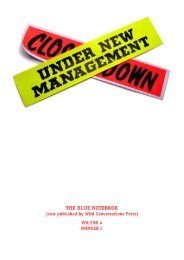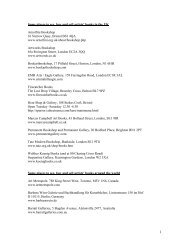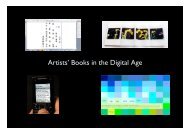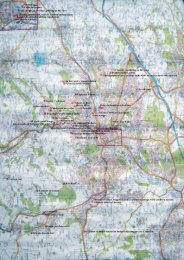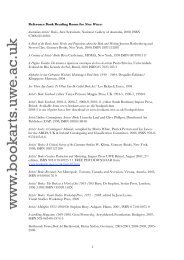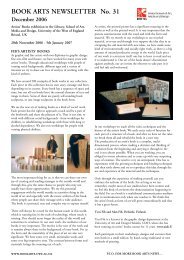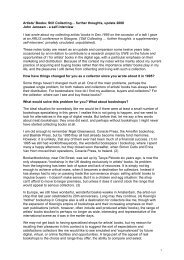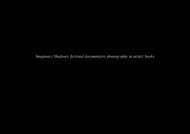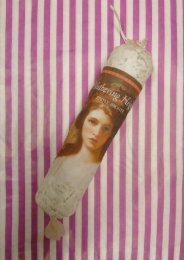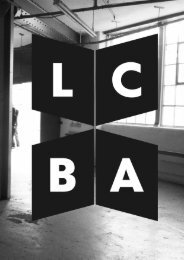Artist's Book Yearbook 2003-2005 - Book Arts - University of the ...
Artist's Book Yearbook 2003-2005 - Book Arts - University of the ...
Artist's Book Yearbook 2003-2005 - Book Arts - University of the ...
You also want an ePaper? Increase the reach of your titles
YUMPU automatically turns print PDFs into web optimized ePapers that Google loves.
Making <strong>Book</strong>s<br />
Emma Hill<br />
Moving house two years ago, I counted sixteen<br />
boxes that contained my books. I have books<br />
from four generations <strong>of</strong> my family. <strong>Book</strong>s I<br />
have re-read at intervals throughout my life and<br />
o<strong>the</strong>r books I will probably never read but keep<br />
because <strong>the</strong>y have become in some way familiar.<br />
As Calvino understands you can read a person's<br />
life by looking at <strong>the</strong>ir books, <strong>the</strong>y represent<br />
<strong>the</strong> past and are held, with unknown potential,<br />
for <strong>the</strong> future.<br />
I make books because I think books are<br />
important. When you take a book into your<br />
hands you are taken on a journey that leaves<br />
you somewhere different from where you<br />
started. I make artists’ books because <strong>the</strong>y can<br />
contain more than one creative language in a<br />
structure that holds time. I make books for <strong>the</strong><br />
same reason I imagine most people are drawn<br />
to making <strong>the</strong>m, because <strong>the</strong>y are satisfying to<br />
make.<br />
As a publisher <strong>of</strong> books which bring toge<strong>the</strong>r<br />
<strong>the</strong> work <strong>of</strong> contemporary artists and writers<br />
one enters interesting but problematic<br />
territory. The experience <strong>of</strong> a book is generally<br />
a private one, a subjective ga<strong>the</strong>ring <strong>of</strong> images<br />
in <strong>the</strong> mind to visualise <strong>the</strong> words we read, fluid<br />
and individual to each reader. A work which<br />
attempts to ‘make visual’ words, to create visual<br />
narrative, or to play conceptually upon <strong>the</strong><br />
'bookness' <strong>of</strong> itself, is by nature a hybrid thing<br />
and risks overloading <strong>the</strong> space where what you<br />
see or read becomes real in <strong>the</strong> mind's eye.<br />
Good artists' books are never merely illustrative.<br />
The best <strong>of</strong> <strong>the</strong>m integrate formal qualities to<br />
create “harmony among our various modes <strong>of</strong><br />
perception...” 1 - <strong>the</strong> intangible effect all good<br />
art has to provoke a sense <strong>of</strong> recognition, even<br />
in <strong>the</strong> first glance.<br />
A book comes with a certain set <strong>of</strong> rules which<br />
can be utilised or broken and I am less<br />
interested in debating what an artist's book is<br />
than in finding out what an artist's book can be.<br />
I am encouraged by <strong>the</strong> view that “a book is a<br />
space for imaginative action” 2 - a particular<br />
kind <strong>of</strong> site where an artist can use what we<br />
95<br />
understand about how a book holds language<br />
to make us pause, contemplate and look anew.<br />
Over <strong>the</strong> last ten years I have published books<br />
which range from unique objects to limited<br />
run, hand printed books to long-run<br />
commercially printed editions. The only<br />
defining feature <strong>of</strong> <strong>the</strong> imprint is that it brings<br />
toge<strong>the</strong>r words with images and in most<br />
instances words which have been written<br />
contemporaneously with <strong>the</strong> making <strong>of</strong> <strong>the</strong><br />
images. Early books tended to be made as a<br />
record <strong>of</strong> temporary installations at <strong>the</strong> Eagle<br />
Gallery and were simple letterpress, block print<br />
or litho publications. The gallery is situated in<br />
an area <strong>of</strong> London traditionally associated with<br />
printing and in <strong>the</strong> early 90’s still had a<br />
working community <strong>of</strong> small scale commercial<br />
print workshops, which made printing <strong>the</strong><br />
books financially possible.<br />
In 1992 Bruce McLean and Mel Gooding’s<br />
Knife Edge Texts brought toge<strong>the</strong>r <strong>the</strong> writing<br />
from <strong>the</strong>ir previous collaborations in a simple<br />
board bound book printed entirely in letterpress<br />
by Tom Shaw. McLean liked <strong>the</strong><br />
utilitarian feel <strong>of</strong> <strong>the</strong> blank billboard covers and<br />
incorporated a line <strong>of</strong> <strong>the</strong> books on <strong>the</strong> wall <strong>of</strong><br />
<strong>the</strong> installation Knife Edge at <strong>the</strong> Eagle: Ano<strong>the</strong>r<br />
Situation: No Style. Having a gallery it seemed to<br />
make sense to show books in <strong>the</strong> same way as<br />
we showed o<strong>the</strong>r art works and to present <strong>the</strong>m<br />
in a context where <strong>the</strong>y were not an adjunct to<br />
<strong>the</strong> o<strong>the</strong>r objects but attendant to <strong>the</strong>m. It was<br />
important to make <strong>the</strong>m accessible and<br />
readable. I can't see <strong>the</strong> point <strong>of</strong> making a book<br />
with text if <strong>the</strong> viewer can't read it and however<br />
precious a book is, <strong>the</strong> experience <strong>of</strong> it as an<br />
object is lost if contained in a glass case.<br />
In 1995 I was approached by Terry Smith, who<br />
was gaining recognition as an installation artist<br />
and had recently made a number <strong>of</strong><br />
interventions in a group <strong>of</strong> Acme houses in <strong>the</strong><br />
east end <strong>of</strong> London which had been cleared to<br />
make way for <strong>the</strong> M11 link road.<br />
Smith’s work by <strong>the</strong>n existed only as<br />
documentation - sequences <strong>of</strong> mainly black and<br />
white photographs which showed how he had<br />
referenced <strong>the</strong> histories <strong>of</strong> <strong>the</strong>se spaces in<br />
simple, eloquent repetitions <strong>of</strong> architectural<br />
details, cut directly into <strong>the</strong> walls.




